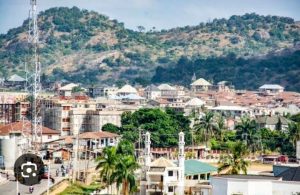

By Dada Ahmed.

Okene township.
(C) Ebira online.
Kogi Central Senatorial District, comprising the five local government areas of Okene, Adavi, Okehi, Ajaokuta, and Ogori/Magongo, is a region abundantly blessed with natural resources and a rich cultural heritage. Despite its vast potential, the district continues to grapple with underdevelopment and a lack of industrial growth. The need for a deliberate industrialization strategy,driven primarily by its own people,has never been more urgent.
This district is home to some of Nigeria’s most valuable solid minerals, including iron ore, limestone, dolomite, and granite. Ajaokuta alone houses one of the largest steel complexes in Africa, albeit dormant. The Itakpe iron ore deposit is of global significance, supplying raw materials for steel production. Yet, the district has remained largely on the sidelines of Nigeria’s industrial map due to inadequate investment, poor infrastructure, and limited political will.
Beyond solid minerals, Kogi Central has immense commercial and economic prospects. The district lies strategically on the transport corridor linking North and South Nigeria. Its markets in Okene and Adavi serve as major trade hubs for agricultural produce, textiles, and household goods. With a growing population, skilled manpower, and a budding entrepreneurial culture, the foundation for industrial take-off already exists.
However, industrialization cannot be externally driven alone. It requires a homegrown strategy rooted in community participation, local investment, and strong political advocacy. Indigenes must recognize that the development of Kogi Central is not just the responsibility of the government but also of private individuals, traditional rulers, professionals, and youth.
One key pathway is through the formation of cooperatives and investment clubs by indigenes at home and in the diaspora. Pooling resources to establish small-scale processing plants,like cassava, rice, or palm oil millscan reduce unemployment and promote economic self-reliance. In mineral-rich areas, community-driven partnerships with licensed miners can ensure value is added locally before raw materials leave the district.
Entrepreneurs from the district must begin to see themselves as industrial catalysts rather than just traders or service providers. The establishment of local manufacturing outfits,cement from limestone, tiles from granite, and metal fabrication industries,can kickstart a chain of industrial activities that will benefit future generations.
Education and skills acquisition are also crucial. Indigenes should invest in technical and vocational training centers to equip the youth with the skills needed to operate and maintain industrial machinery. A technically trained workforce will attract investors who seek local talent to reduce operational costs.
Political advocacy and policy influence are equally important. Kogi Central representatives at all levels must champion bills and policies that favor the creation of industrial hubs, tax incentives for local investors, and infrastructure development like roads, electricity, and water supply. These will create an enabling environment for industries to thrive.
The role of traditional and religious institutions should not be underestimated. These structures command significant respect and influence. By promoting peace, encouraging investment, and partnering with development-oriented groups, they can help transform the district into a beacon of progress.
Women and youth also have critical roles to play. Youth-led agribusinesses, ICT-driven innovations, and women-run cooperatives can drive industrialization from the grassroots. They must be included in planning, implementation, and monitoring of development projects across the district.
Diaspora engagement offers a unique advantage. Many sons and daughters of Kogi Central are excelling in various fields globally. Establishing an Industrial Development Trust Fund supported by the diaspora could fast-track the construction of industrial parks and incubation centers for startups.
There is also the opportunity for synergy between local governments within the district. A united regional industrialization blueprint,rather than fragmented efforts,will attract more attention, investment, and government support. Such synergy could lead to the creation of a Kogi Central Industrial Council, driven by stakeholders across the five LGAs.
Ultimately, the industrialization of Kogi Central requires a shift in mindset. Indigenes must begin to think long-term, act collectively, and invest deliberately. The wealth beneath and around the soil is useless unless transformed into economic value through local action and purposeful leadership.
In the final analysis,it must be stressed that industrialization Kogi Central is not just a development goal,it is a necessity for survival, dignity, and prosperity. The time has come for its indigenes to rise beyond lamentation and take bold steps toward industrial self-determination. The vision is clear, the resources are available, and the responsibility lies with the people.
Ahmed, an indigene of kogi central,publishes The Reporters.
ahmeddada008@gmail.com.

